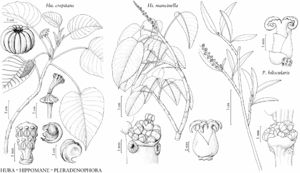Hippomane mancinella
Sp. Pl. 2: 1191. 1753.
Trees, to 7 m with much-branched spreading crown; bark light gray or light brown, ± smooth, slightly warty and fissured; latex copious, caustic. Leaves: stipules caducous, ± narrowly deltate, 1 mm, margins entire; petiole slender, 1–6 cm, varying in length on single branchlets, with 1 disc-shaped sessile gland abaxially at apex; blade broadly ovate-elliptic, 2–9 × 1–7 cm, chartaceous, shiny adaxially, base rounded or slightly cordate, margins remotely crenate, apex obtuse or short-acuminate; midvein prominent, secondary veins less prominent. Inflorescences 6–8 cm; staminate cymules subsessile, clearly separated, 10–30-flowered; pistillate flowers 2–3; bracts flabelliform, 1–2 mm. Staminate pedicels 1 mm. Staminate flowers: calyx 1 mm, lobes broad, shallow. Pistillate flowers: styles thick, to 10 mm, strongly recurved. Drupes depressed-globose, 1.5–2.5 cm diam. Seeds smooth.
Phenology: Flowering Jan–May; fruiting (Mar–)May–Sep.
Habitat: Hammocks and low ground behind mangrove zone along coast.
Elevation: 0–10 m.
Distribution
Fla., Mexico, West Indies, Central America, n South America, Pacific Islands (Galápagos Islands).
Discussion
In the flora area, Hippomane mancinella is found only in Miami-Dade and Monroe counties. The caustic latex can cause severe skin irritation on contact and, if taken internally, can cause severe poisoning, although individual reactions can vary dramatically (R. A. Howard 1981). The applelike appearance of the fruit no doubt has been the cause of more frequent poisonings than might otherwise be the case (G. L. Webster 1967). Smoke from burning wood can be harmful to the eyes (R. W. Long and O. Lakela 1971; W. C. Burger and M. J. Huft 1995).
Selected References
None.
